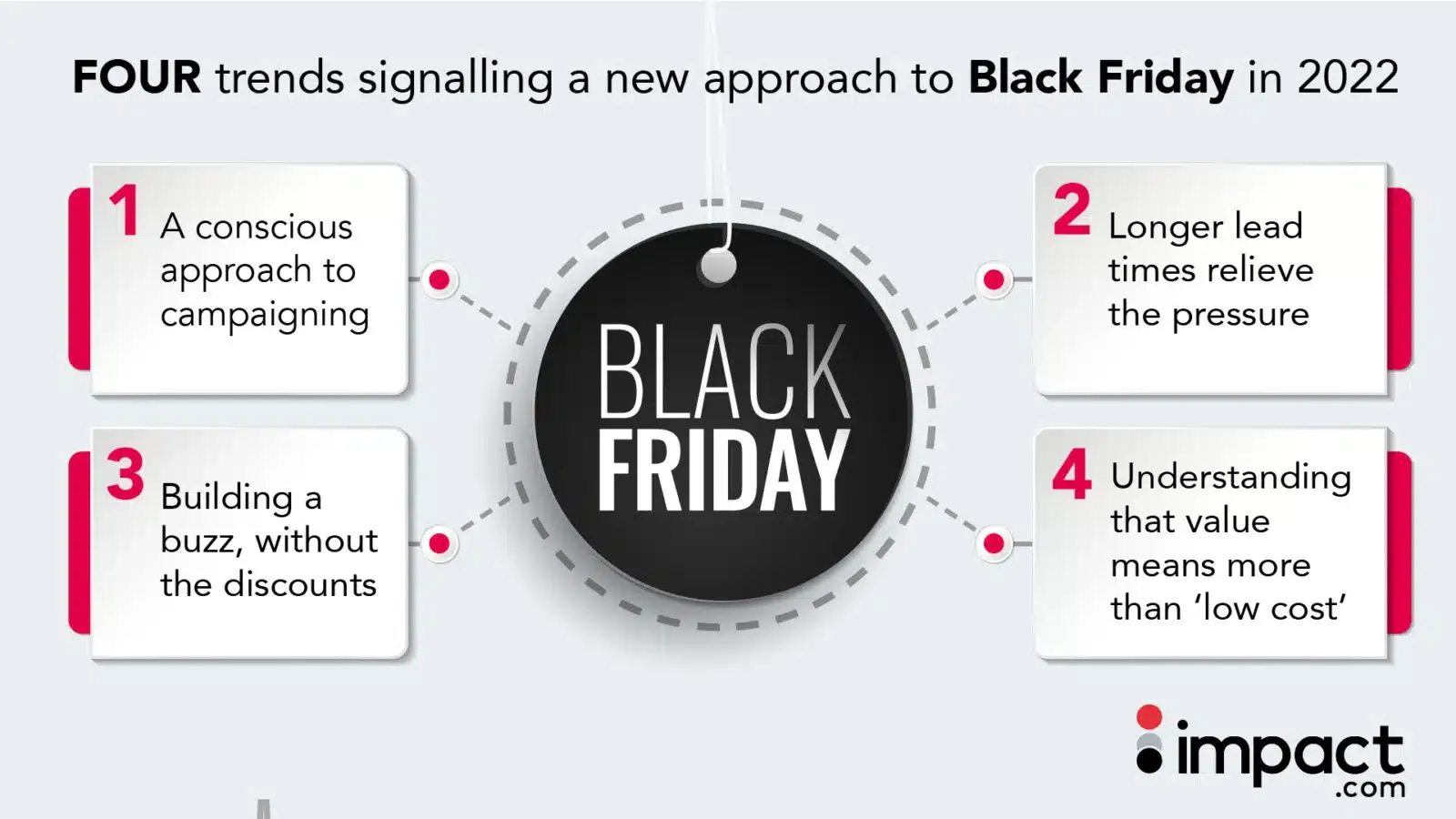FOUR TRENDS SIGNALLING A NEW APPROACH TO BLACK FRIDAY IN 2022

Black Friday has long been anticipated as one of the biggest shopping events in the retail calendar, drawing in millions of consumers with promises of low prices and unbeatable offers. However, this year is set to look a little different, with economic and environmental concerns a priority for consumers and brands.
The cost of living crisis continues to shape the nation’s spending habits, with experts predicting that overall, Black Friday spending will drop by £850 million in 2022, down 18% from last year. Those who do intend to spend appear to be less motivated by the buzz of the event – as was typical in the early years – and more by a sense of managing budgets at this time of year. Reports show that 41% of UK shoppers are counting on brands to discount products so they can put presents under the tree this festive season.
Brands are also feeling the strain, as they enter into Q4 with the knowledge that their annual profit could be dependent on their sales in the weeks running up to December 25th. Meanwhile, many are under pressure to address rising climate concerns, as consumers are increasingly choosing to shop with more sustainable brands or buy second-hand in order to minimise their environmental impact.
As Black Friday approaches, we take a look at some of the key trends that are emerging as a response to this period of economic and environmental uncertainty.
1. A Conscious Approach To Campaigns
We’re hearing from our retail brands that consumers are being much more intentional when it comes to making purchases, opting to buy only what they need and to shop more sustainably for essential products. It’s no longer enough to centre Black Friday campaigns around rock-bottom prices; if anything, consumers are more tuned-in than ever to the issues at hand and are unlikely to be pressured into making impulse purchases. As a result, we’re seeing a real shift towards sensitivity in brand communications, with brands working hard to demonstrate an awareness of their customers’ wants and needs.
IKEA’s 2021 Black Friday campaign (which is set to return in 2022) offers a great example of this approach, opting to celebrate ‘Green Friday’ by incentivising customers to use its Buyback & Resell scheme in return for 50% off new items.
2. Longer Lead Times Relieve The Pressure
Another key trend we’ve seen this year is a longer lead time ahead of the Black Friday promotions. In previous years, search interest in the term “Black Friday” started to rise 7 weeks prior to the event. This year, however, search interest started to rise 12 weeks before Black Friday. Many brands such as Swarovski, John Lewis & Partners, ASOS, Lovehoney, Liberty, Whistles and Sweaty Betty have responded to this advance interest by beginning their campaigns much earlier than usual to create more of a conversation with their customers.
Girlfriend Collective is a great example of a brand actively using this extra time to prepare their customer for the upcoming promotion, advising them on the best and most conscious way to make the most of the offers, without “panic scrolling or impulse buying.”
3. Building A Buzz, Without The Discounts
Many brands, particularly independent brands, cannot afford to significantly reduce their prices this year, especially given the pressure they’re facing to build revenue in the last quarter. What’s more, several are now finding that ‘low-cost, high-volume’ sales no longer align with their brand values and their commitment to a more sustainable business model.
As such, we’ve seen a number of brands taking advantage of the buzz around Black Friday to host alternative offers, such as previews or new collection launches, or member-only events that seek to reinforce brand loyalty, rather than frivolous spending.
4. Understanding That Value Means More Than ‘Low Cost’
Value for customers no longer means ‘low cost.’ Rather, customers are looking to build ongoing relationships with brands who understand, and are able to anticipate, their needs in order to offer real-world value, whether that’s in the products they purchase or their experience across a brand’s multiple touchpoints.
This kind of considered approach initially seems incompatible with the fast-paced, low-commitment nature of Black Friday, but there are a number of ways in which brands can offer real value as part of the retail event, from personalised offers to omni-channel campaigns that offer a seamless and enjoyable way to engage with a brand.
The Future Of Black Friday
This year, it’s clear that a lot of brands are taking a more thoughtful approach to Black Friday, returning to their core values and spending more time thinking about how they can participate in a way that feels true to their identity and will reinforce the relationship they have with their customers.
But without the viral appeal of record-breaking offers, brands will need to leverage new tools to drive revenue, such as strategic partnerships and integrations. Partnerships offer a route to the consumer through websites and influencers they trust, allowing brands to demonstrate their awareness of the delicate financial situation many consumers are in, while still highlighting the offers they have. If brands can effectively strike this balance, we’re likely to see a long-term shift in the approach to Black Friday in the coming years.
Also Published in:
Modern Retail



